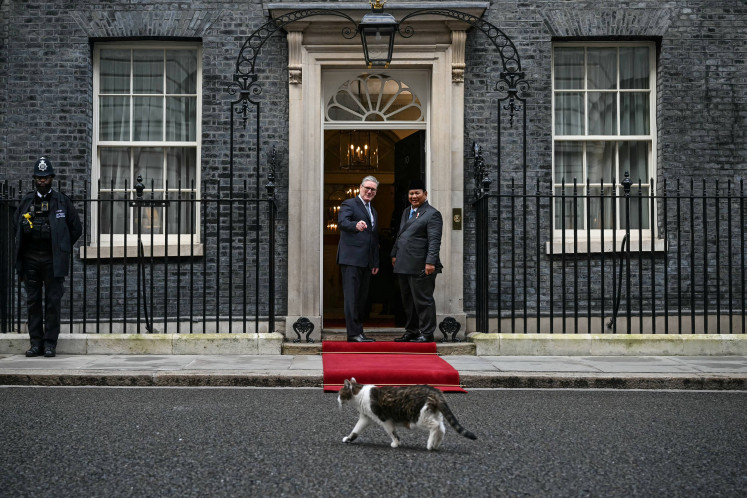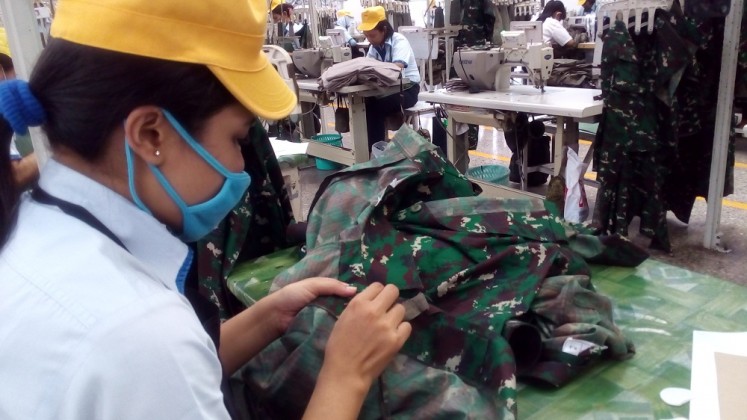Popular Reads
Top Results
Can't find what you're looking for?
View all search resultsPopular Reads
Top Results
Can't find what you're looking for?
View all search resultsContemplation for Air Force improvement
The Indonesian Air Force celebrated its 63rd anniversary Thursday (April 9) in a solemn manner, just three days after a plane crash in Bandung killed 24 of its personnel
Change text size
Gift Premium Articles
to Anyone
The Indonesian Air Force celebrated its 63rd anniversary Thursday (April 9) in a solemn manner, just three days after a plane crash in Bandung killed 24 of its personnel.
The six crew of the Fokker F-27 Troopship medium transport airplane and 18 soldiers from the Air Force’s Special Forces (Paskhas) were killed when the plane rammed into the roof of a hangar when trying to land at Husein Sastranegara Air Force Base in Bandung during bad weather.
The ill-fated plane was from the Air Force 2nd squadron based at Halim Perdanakusuma Air Force Base in Jakarta.
The Dutch-made F-27, designed and first produced in the 1950s, is a versatile and popular twin turboprop airplane used by both civilian and military operators. It is dubbed the most successful western European civilian turboprop plane.
While the accident was likely caused by bad weather, despite the fact the plane was made in 1976, the accident served as yet (another) stark reminder of how fragile our knights of the sky are. The Air Force has yet to fully acquire what it needs to completely guard the country’s airspace from Sabang to Merauke, Miangas to Rote.
The government may have been generous enough to buy state-of-the-art Sukhoi fighter jets for deterrence purposes, but there are more than enough sophisticated fighters for a professional air force to operate properly.
Indonesia was still under a total military embargo sanctioned by the United States at that time, affecting most of the US-made Hercules fleet. While the US partially lifted the embargo for non-lethal goods, the damage was done as it took time to get the grounded fleet airworthy again.
Being too dependent on one country has proven troublesome, as the provider often insists on terms and conditions that are not beneficial to Indonesia.
It is quite baffling that the government did not take any preparatory measures when the US first put in place an arms embargo in 1992, following the Santa Cruz incident
in East Timor.
A total US embargo was sanctioned in 1999 over the chaotic situation in the impoverished former Portuguese colony that had overwhelmingly decided to secede from Indonesia.
Perhaps relying on its good-boy image among Western governments, the government decided it was not necessary to alter its source of weaponry, which may have further tainted its image.
This approach, however, has definitely sacrificed not only the Air Force’s readiness, and the TNI’s in general, but also the domestic defense and strategic industries that are mostly state-owned.
One could see Iran as a role mo-del in self-sufficiency, as they managed to modify the US-made F-5E Tiger II fighter jet into the native Saeqeh (Thunderbolt) single-seater fighter jet.
Iran has been under embargo since the Shah was ousted in 1979, but managed to keep its fleet of American-made Tigers and F-14 Tomcats flying. While the spare-parts could be acquired on the black market, thanks to Iran’s petrodollar, the technical skills to keep them flying were also necessary.
But perhaps Indonesia is not as rich as Iran to be able to fully develop its own industry to offset the embargo.
The Indonesian government also prefers to procure aircraft from other countries, although aircraft of similar specifications could be made at home by state-owned PT Dirgantara Indonesia (PT DI).
One example is the M-28 Skytruck light transport aircraft produced by PZL Mielec of Poland. PT DI is already capable of producing the NC-212-200, which is in the same class as the Polish aircraft.
Perhaps the fact the Skytrucks were offered through export credit made the government decide to accept them.
Many skeptics have called for the dissolution of PT DI, saying it is simply a white elephant whose funding can be channeled to other pressing sectors such as poverty alleviation and agriculture.
However, they might be surprised (or proclaim disbelief) to learn that South Korea is procuring another four CN-235 airplanes from PT DI.
The South Korean government and PT DI signed a contract worth US$92 million on Dec. 29, 2008, for a maritime patrol aircraft (MPA) version of the twin-turboprop aircraft developed together with Spain.
South Korea previously procured eight Indonesian-made CN-235-220Ms in December 2001. Six are in service with the 258th Tactical Air Transport Squadron, while two VIP versions are with the 296th Squadron.
The Republic of Korea Air Force (ROKAF) also acquired a number of CN-235-100 made by Spain for a total of 20 CN-235s.
Indonesians should be proud that the CN-235 is being used by various countries across the globe, from neighbors Brunei Darussalam, Malaysia and Thailand, to countries as far afield as Pakistan, Turkey and Venezuela.
Another prominent user of the airplane is the United States Coast Guard, which procured the aircraft from CASA EADS from Spain. The USCG designates the airplane the HC-144A for its MRS MPA (Medium Range Surveillance Maritime Patrol Aircraft) program.
Although ordered through Spain, PT DI was also involved in the program, as the assembly of the CN-235 involves both PT DI and CASA EADS.
It is high time the government procure more domestic products in the defense sector, no matter how expensive it may initially seem. The stake is not only for the present, but most certainly for the future.
May our wings of the motherland face up to the future challenges.
The author is a staff writer at The Jakarta Post.










